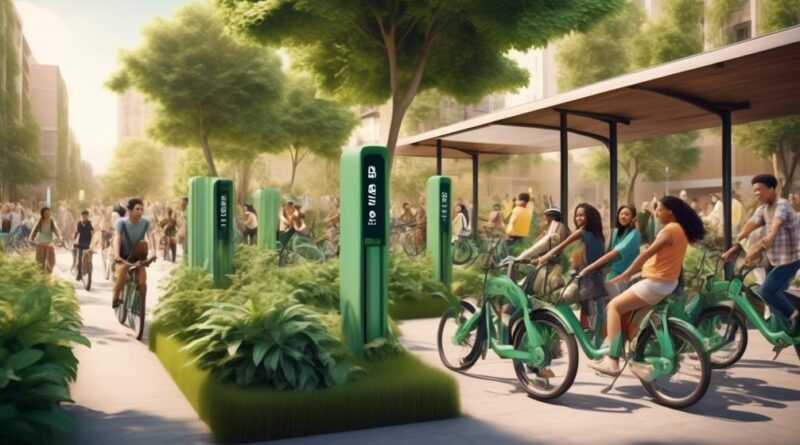5 Easy Ways to Encourage Eco-Friendly Transportation Locally
You know the importance of reducing carbon emissions and promoting sustainability in your community. But have you considered the impact of local transportation choices?
There are simple, effective ways to encourage eco-friendly transportation options right in your own neighborhood. By implementing these strategies, you can make a tangible difference in reducing environmental impact and fostering a more sustainable way of moving around.
Community Bike Sharing Programs
Have you ever wondered how community bike sharing programs can make eco-friendly transportation more accessible and convenient for you?
Community bike sharing programs are an excellent way to promote sustainable transportation and reduce the reliance on cars. One of the key benefits of these programs is the emphasis on bike safety. With more people using bikes as a mode of transportation, it becomes increasingly important to ensure that riders are equipped with the knowledge and resources to stay safe on the road. Many community bike sharing programs offer safety workshops and resources to educate riders about proper helmet use, road etiquette, and bike maintenance, fostering a culture of safety and responsibility among users.
Funding sources play a crucial role in the success and expansion of community bike sharing programs. These initiatives often rely on a combination of public and private funding to cover initial setup costs, maintenance, and expansion. Public funding can come from local government budgets, grants, or partnerships with transportation agencies, while private funding may come from corporate sponsorships, donations, or user membership fees. By diversifying funding sources, these programs can ensure their sustainability and accessibility to a wider community.
Carpooling and Ridesharing Initiatives
Carpooling and ridesharing initiatives offer a cost-effective and environmentally friendly way for you to share rides with others in your community. Incentivizing carpooling can be achieved through various means, such as designated carpool lanes, reduced parking fees for carpool vehicles, or even tax incentives for participants. These incentives not only save you money but also help reduce traffic congestion and lower greenhouse gas emissions.
Ridesharing partnerships between local businesses and transportation companies can further encourage the use of shared rides. By collaborating with ridesharing services, businesses can provide their employees with convenient and affordable commuting options. Additionally, offering rewards or recognition for employees who choose to carpool or rideshare can motivate more individuals to participate in these initiatives.
You can also take the initiative to organize a carpooling or ridesharing group in your neighborhood or workplace. Social media platforms and community bulletin boards can be utilized to connect with potential carpool partners. By sharing the responsibility of driving, you can reduce your individual carbon footprint and build camaraderie with fellow commuters.
Infrastructure for Walking and Biking
To enhance eco-friendly transportation locally, consider investing in infrastructure for walking and biking to promote sustainable and healthy commuting options. Creating a bike-friendly environment requires careful urban planning and the implementation of specific features to ensure the safety and convenience of cyclists and pedestrians. Here are some vital elements that can contribute to developing a more bike and pedestrian-friendly community:
- Safe Pathways: Building designated pathways for pedestrians and cyclists separate from vehicular traffic can significantly enhance safety and encourage more people to walk and cycle.
- Bike Lanes: Installing dedicated bike lanes on roads can provide a protected space for cyclists, making it safer for them to navigate through urban areas.
- Pedestrian Bridges: Constructing pedestrian bridges over busy roads or highways can improve safety and accessibility for walkers and bikers, reducing the risk of accidents.
- Bike Racks: Installing bike racks at public facilities, business districts, and transport hubs encourages people to cycle by providing secure parking for their bikes.
- Sidewalk Improvements: Enhancing and maintaining sidewalks with smooth surfaces, adequate lighting, and clear signage creates a safer and more accommodating environment for pedestrians.
Public Transportation Advocacy
Considering the benefits of sustainable commuting options, advocating for public transportation in your community can further alleviate environmental impact and promote accessibility for all individuals. Transit accessibility is crucial for creating a more inclusive and environmentally friendly transportation system. By advocating for improved public transit options, you can help ensure that everyone, regardless of their economic status or physical abilities, has access to reliable and efficient transportation. This can lead to reduced traffic congestion, lower greenhouse gas emissions, and better air quality in your community.
When advocating for public transportation, it's important to stay informed about funding opportunities. Many local, state, and federal programs provide grants and other financial resources to support the development and improvement of public transit systems. By staying engaged with your local government and transportation agencies, you can help identify and pursue these funding opportunities to enhance public transit options in your area.
Whether it's securing funding for new infrastructure, upgrading existing transit vehicles, or implementing technology to improve the rider experience, advocating for funding can make a tangible difference in the accessibility and sustainability of public transportation in your community.
Promoting Electric Vehicles
Promoting electric vehicles can significantly reduce greenhouse gas emissions and contribute to a cleaner, more sustainable transportation system. To encourage the adoption of electric vehicles in your community, consider the following:
- Incentivizing rebates: Local and state governments often offer rebates or financial incentives for purchasing electric vehicles. These can significantly lower the upfront cost and make electric vehicles more accessible to a wider range of consumers.
- Charging stations: Advocate for the installation of public charging stations in your area. Increased access to charging infrastructure can alleviate range anxiety and make electric vehicles a more practical option for residents.
- Government incentives: Stay informed about government incentives and programs that support electric vehicle adoption. These can include grants for installing charging infrastructure, funding for electric vehicle research, and initiatives to promote electric vehicle use in public fleets.
- Tax credits: Federal tax credits are available for purchasing electric vehicles. These credits can help offset the initial investment and make electric vehicles more financially attractive.
- Education and outreach: Host events or workshops to educate the community about the benefits of electric vehicles. Providing information about cost savings, environmental impact, and available incentives can help dispel misconceptions and encourage more people to consider electric vehicles as a viable transportation option.
Encouraging Telecommuting and Remote Work
Encouraging telecommuting and remote work presents an additional opportunity to reduce greenhouse gas emissions and promote sustainable transportation practices in your community. Promoting flexible schedules allows employees to work from home on certain days, reducing the number of cars on the road and lessening traffic congestion. This not only helps to lower carbon emissions but also contributes to a more efficient use of fuel and resources.
In addition, remote collaboration opportunities enable employees to connect virtually, eliminating the need for daily commutes to the office. By leveraging technology for meetings, conferences, and project collaborations, individuals can significantly cut down on their transportation-related carbon footprint. Encouraging telecommuting and remote work can also lead to a more balanced work-life routine for employees, reducing stress and improving overall well-being.
Businesses and organizations can play a pivotal role in promoting telecommuting and remote work by implementing policies that support flexible work arrangements. Embracing remote work not only benefits the environment but also offers cost savings for employers and employees, including reduced fuel expenses and office overhead.
Educating on Sustainable Transportation Options

To promote sustainable transportation options, educate the community about eco-friendly commuting alternatives and their benefits. By promoting green commuting, you can make a significant impact on reducing carbon emissions and improving air quality. Here are some ways to educate the community on sustainable travel options:
- Host Workshops: Organize workshops to educate people about carpooling, biking, walking, and public transportation options. Provide information on the environmental and health benefits of these alternatives.
- Collaborate with Local Schools: Partner with schools to educate students and parents about sustainable transportation options. Encourage students to walk or bike to school and educate parents about the benefits of carpooling.
- Create Informational Materials: Develop brochures, flyers, and online resources that outline sustainable travel options, including maps of bike lanes, public transit routes, and carpooling information.
- Community Events: Host community events centered around promoting sustainable transportation. Feature demonstrations, guest speakers, and interactive activities to showcase the benefits of eco-friendly commuting.
- Incentive Programs: Establish incentive programs to encourage people to choose sustainable transportation options. Offer rewards for carpooling, biking, or using public transportation, such as discounts at local businesses or entry into raffles.
Supporting Local Eco-Friendly Transportation Businesses
Now that you've educated the community about sustainable transportation options, it's time to explore ways to actively support local eco-friendly transportation businesses.
One impactful way to do this is by utilizing eco-friendly shuttle services provided by local businesses. These shuttle services often run on clean energy sources and have optimized routes, reducing emissions and traffic congestion. By choosing these services for your transportation needs, you directly contribute to the success and sustainability of local eco-friendly transportation businesses.
Additionally, consider participating in and promoting green transportation events organized by these businesses. These events could include community bike rides, electric vehicle showcases, or public transportation awareness campaigns. By attending and spreading the word about these events, you help increase the visibility and viability of eco-friendly transportation options in your local area.
Another way to support local eco-friendly transportation businesses is by providing feedback and testimonials. If you've had a positive experience with a specific eco-friendly transportation service, share your feedback online or through word of mouth. Positive reviews and testimonials can significantly impact a business's reputation and attract more customers, further promoting sustainable transportation choices in your community.
Additionally, consider advocating for local government support for eco-friendly transportation businesses. This could involve writing to local officials, attending town hall meetings, or joining advocacy groups to push for policies that encourage and support sustainable transportation initiatives at a local level.
Frequently Asked Questions
How Can Local Governments and Organizations Collaborate to Create Safer and More Accessible Walking and Biking Infrastructure in Urban Areas?
To create safer streets and accessible walking and biking infrastructure in urban areas, collaborate with local governments and organizations. Advocate for community collaboration, prioritize safety, and invest in infrastructure improvements to encourage eco-friendly transportation.
What Are the Potential Economic and Environmental Benefits of Promoting Electric Vehicles in Local Communities?
To promote electric vehicles in your community, consider the economic growth from reduced fuel costs and environmental impact of lower emissions. Encouraging EV infrastructure and providing incentives can lead to a cleaner, more sustainable future.
What Are Some Innovative Ways to Incentivize and Promote Telecommuting and Remote Work as a Sustainable Transportation Option?
To promote telecommuting and remote work as sustainable options, consider implementing incentive programs for employees. Highlight the benefits of remote work, provide telecommuting resources, and encourage sustainable commuting options to reduce environmental impact.
How Can Local Businesses and Organizations Work Together to Support and Promote Eco-Friendly Transportation Options in the Community?
You can collaborate on sustainable initiatives by forming community partnerships between local businesses and organizations to support and promote eco-friendly transportation options. This can involve offering incentives, creating shared transportation programs, and advocating for infrastructure improvements.
What Are the Potential Challenges and Solutions to Implementing Public Transportation Advocacy in Smaller, Rural Communities?
In smaller, rural communities, challenges to public transportation advocacy include limited funding and sparse population. Solutions involve community partnerships, flexible scheduling, and promoting the environmental and economic benefits of eco-friendly transportation options.
Conclusion
So, now you have some simple and effective ways to promote eco-friendly transportation in your local community.
By supporting initiatives like bike sharing, carpooling, and public transportation, you can make a positive impact on the environment and reduce carbon emissions.
Encouraging sustainable transportation options and supporting local businesses will help create a more eco-friendly and sustainable community for everyone.
Start making a difference today!
